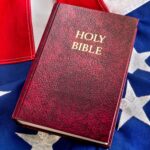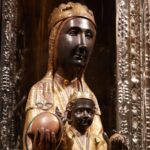
Dr. M. Elizabeth Thorpe and Rev. Deborah Duguid-May discuss the impact of living under the oppression of the Roman Empire in the Nativity Story in this third part of our six part series on the birth of Christ.
Transcript
DDM [00:03] Hello and welcome to The Priest and the Prof. I am your host, the Rev. Deborah Duguid-May.
MET [00:11] And I’m Dr. M. Elizabeth Thorpe.
DDM [00:12] This podcast is a product of Trinity Episcopal Church in Greece, New York. I’m an Episcopal priest of 26 years, and Elizabeth has been a rhetoric professor since 2010. And so join us as we explore the intersections of faith, community, politics, philosophy, and action.
MET [00:38] We’re continuing our exploration of the nativity story today, but we’re talking about Christ’s birth as a political story. Specifically, we’re talking about empire. We’ve touched on that as we’ve moved through the story, but I want to address it explicitly. You may remember from the very beginning of this podcast that I told you that one of the things that drew me to my faith, that made me feel connected to this story of Christianity, was the political nature of Jesus.
MET [01:11] I understand Jesus as a political radical. He challenged power and authority. And if you listen to the Religious Liberty episode that I did with producer Carl, you know that I firmly believe Christ did not come to be a king on earth. But I do think he came to challenge kings and other authorities.
MET [01:33] If you ignore the politics of Jesus’ story, you’re ignoring a huge part of the gospel. I think that’s like ignoring the politics of somebody like MLK or Cesar Chavez, who we’ve talked about extensively. But people do it all the time. Because if you take the politics of Christ seriously, then the politics we live in becomes very uncomfortable. right?
MET [01:56] Christ challenged power, greed, financial systems, organized religion, and tradition. And we have to ignore all that and sanitize it. Otherwise, we have to deal with the fact that most of the institutional church does none of that. So, I want to talk about the political nature of the stories in Luke and Matthew.
MET [02:17] We don’t often think of them in those terms because it seems contrary to the spirit of the season, but maybe that’s a problem for the church. So let’s start with Luke. On the one hand, Luke doesn’t seem particularly political. I talked a lot about class and economics in this story a few weeks ago, and that is fairly obvious.
MET [02:38] It is a story about poor people coming together to celebrate each other. But there’s questions as to why they were poor. Luke starts out with an explicitly political opening. Mary and Joseph weren’t just going to Bethlehem for giggles.
MET [02:54] Caesar had sent out a decree that everyone in all the earth, or everyone in all of Rome anyway, should be counted in a census. For tax purposes. So all families had to return to their city of origin to be counted for Rome’s records. It may not seem like a big part of the story, and maybe it is just setting up why Mary and Joseph were in Bethlehem instead of Galilee, but this tells us some very important things.
MET [03:21] Joseph and Mary are subjects of Rome, and not just as in they are Roman citizens, but they pay fealty to Rome. Being a subject of Rome, not a citizen of Rome, but – Very big difference. Yes, there’s a big difference, and that’s something that has to be contended with. They were conquered by Rome.
MET [03:43] There was no chance not to just not make the trip. Joseph and Mary knew that, even in Mary’s condition, this was a requirement. Rome beckoned, and they had to heed the call. Rome is in charge of this story from the very beginning.
MET [04:00] Rome is the backdrop that you can’t forget. Rome is the exigence and, in many ways, the engine of this tale. Christ’s birth is engineered by political powers. And Joseph and Mary weren’t just making a trip, they were pretty much going there to sign up to be taxed.
MET [04:18] So in this story, Luke is setting up that this family, like all Jewish families, is beholden to Rome. Jewish families gave their money to Rome. Jewish people’s movements and job opportunities were controlled by Rome. Mary and Joseph are, in so many ways, at the mercy of Rome from the very beginning of this story.
MET [04:39] The reason I am focusing on this small beginning, just a few verses, is because it is a bookend to Christ’s life. As his life starts beholden to Rome, so it ends. Christ’s first breath happens when and where it does because Rome said so. Christ’s last breath before the resurrection did as well.
MET [05:00] Did Rome conquer Jesus? No, absolutely not. In many ways, the resurrection shows us how Christ is beyond political power. But Luke shows us how Christ’s life is defined by political powers.
MET [05:13] Christ is a political figure from his birth to his death in the sense that his life is defined by these political forces. And even beyond the senses, one must consider the birth itself. Christ was visited by the poor, his family was poor, there was no room, so they were basically in a cave. These are all very much systemic issues.
MET [05:35] Rome, like America now, was the richest and most powerful nation in the world. It was also a conquering, imperial, and occupying nation. Roman citizens led very different lives than those they occupied. The political and wealth disparities are a part of this story.
MET [05:54] Jesus’ family were a part of a group that had literally been conquered and absorbed by Rome. Jewish people did not have the rights of Roman citizens, which means they did not have the power or the money. The entire nativity story is a tale of people suffering under the boot of Rome, but still finding ways to celebrate the divine. Even in Luke, a story about healing and lifting people up, the politics are inescapable.
DDM [06:23] Elizabeth, that’s a brilliant summary of Luke’s gospel in relationship to empire. You know, and as Elizabeth said, although Christ comes to challenge the empire and provide another alternative way of being, we really do see in those birth narratives of Luke that God uses even the oppressive dictates of the state, like a census for taxation, as part of the story to fulfill prophecy. And I think that reminds me that, you know, in all things it’s almost like God is working in both the good and the bad in our world.
DDM [06:59] Now that does not mean that we should not challenge and attempt to change what is oppressive and not of God, what is not just. But at the same time I think as people of God we are never to lose hope. Because even in the oppressive harm that the state or other powers are enacting, God is still able to use all of this to birth the kingdom of God. And Luke is reminding those who have power, those who are Roman citizens and privileged, because that’s his readership, That even in the injustices they see, this God is able to use it all to fulfill the will of God.
DDM [07:36] That no oppressive actions can stop this coming salvation of God. And I think we see this tension in our own country at this time. So many Americans are appalled by what they are seeing, appalled by what our country is supporting, the wars. and weapons we build and traffic around the world.
DDM [07:57] I think many Americans have tried so hard to become a different nation, a nation that is more just, more honest, and more genuinely about freedom for all. But the power of the empire can sometimes seem overwhelming, and it is so easy to give up and become despondent. Many of the privileged Gentile converts Luke is speaking to are not directly harmed by Rome, they’re the beneficiaries, and it would be easy for them to feel overwhelmed by the power of their own state and to give up because they can. Luke is reminding them to never give up hope, because even in what is not changed, God will use to bring about justice and salvation.
DDM [08:45] I think in Luke’s Gospel we also see this contrast between Pax Romana, the peace of Rome, versus Christ, the King of Peace. I love that. Rome liked to think of itself as the bringer of peace to the rest of the world, much like the USA prides itself on being the bringer of quote-unquote democracy to the rest of the world. But the reality is nation and lands would be conquered by Rome.
DDM [09:12] Those citizens placed under heavy taxation and their taxes would pay for the very military occupying them and for the increased building of roads so that Rome and its military could actually move around the empire. And it’s interesting to me how taxation and oppression so often go hand in hand. Taxation is very often, even today, used to expand the military and the policing of peoples. So in a way, we pay for the military or police that will turn against us when we are no longer comfortable with the injustices of our own empire.
DDM [09:49] But Rome was using the strong military presence to justify the narrative that they were the bringer of peace. Much like we see ice in the military going into our own cities, today of Chicago, LA, Memphis, claiming to be bringing peace but in reality suppressing any dissent and often provoking riots and protests. And so peace through force, the gospel will teach us is actually not peace. Peace through violence and the military is not peace.
DDM [10:24] Peace through the use of power over people is not peace. This is really the peace of Rome, the peace of the empire, which is in reality the use of force to maintain the empire and its expansion. And so in contrast to this, Luke will show us the peace of Christ, the king of peace who will come naked, vulnerable, amongst the oppressed and the poor as a baby. Christ brings true peace because it is a peace rooted in relationships.
DDM [10:57] Relationships with those who are on the margin that are the targets of Rome’s military. Christ comes to bring peace, not in power and strength, but in human vulnerability that invites one to hold, to touch, to wonder, to see the beauty of. It’s in some ways a very human peace. And so Jesus in Luke’s gospel is reframing literally the concepts of peace, of power, and of salvation.
DDM [11:28] It is Rome versus this child. And Luke’s audience of privileged, educated, wealthy Romans will have to choose between Rome and this child of Bethlehem. And it’s one or the other.
MET [11:43] Okay. I’m going to switch gears for just a second, but not monumentally. The story in Matthew, unlike the story of Luke, pretty much reads like a political thriller. It starts kind of fantastic.
MET [11:59] There’s a dream and an angel, pretty unbelievable stuff, but it quickly transitions into a tale of intrigue, secrecy, and even murder. The thing that sets Matthew apart is the story of the Magi, as I have noted previously, but you can’t talk about the Magi without considering their political import. People do all the time, but you shouldn’t. These are men who crossed the known world in search of a baby.
MET [12:28] These were powerful men, kings or wizards or astrologers. Whoever they were, they were rich and probably came from a place where they were highly respected for their wealth, power, and education. These were men of science and reading. And very importantly, the Magi were not Roman.
MET [12:48] They were foreigners. They came from the East. they may have been Persian or Arabian. We tend to romanticize this because, oh, how amazing, these men came from so far away to worship the sweet baby Jesus.
MET [13:03] But this was a risk. Non-Roman authorities traveled across the known world, kings even, and enter Rome to acknowledge the authority of another non-Roman person. Do you have any idea how dangerous that was? The Persian Empire was one of the other most powerful empires in the world.
MET [13:24] These would have been very important people. And here they go, just galloping into the other most powerful empire and tell another king, hey, we’re here to worship one of the folks you conquered. Surprise! And then when they got there, it was all cloak and dagger.
MET [13:39] They went to the king, and he lied about his intentions. So, these kings had to sneak out of the country, and that first king got furious and ordered all the infants should be murdered. Joseph’s family caught wind of what was coming, and they fled the country as refugees to a neighboring nation outside of the empire. This is a story of competing nations and rival kings.
MET [14:01] Royal figures are crossing proverbial swords over this family. Multiple empires are involved in the early childhood story of this poor family. This is a story of a family who is being tossed about by political whims and forces well beyond their control. Empires and Caesars and kings are making decisions that this family has no say in that are upending their life time and time again.
MET [14:31] This is a story of a family that is politically victimized at every turn. Is it any wonder, then, that Jesus turns into a political radical? From his very birth, Jesus’ family is thrown and kicked around by political forces that just grind down families like his own. If Mary, Joseph, and Jesus were here today, they’d be at the mercy of ICE or DHS, and Jesus would be fomenting his radicalism right now.
MET [15:01] just as he did then. We ignore the politics of Christ’s story because we are very uncomfortable with the idea of him as a political figure. But everything about his early life was a politically explosive event.
DDM [15:17] A hundred percent. And I think we really, as we read scriptures, if we read them honestly, we’re reminded of just the expanse of power of politics. You know, the politics of our day shape who we are and who we will become in ways far beyond what I think most of us even are aware of. And especially if we are not the privileged few, but the ones who are drowning under taxation and oppression.
DDM [15:45] And that is the lens of Matthew’s gospel. You know, taxation was real. People were losing their ancestral land because they could not pay the taxes and had to sell. People were losing livestock because they could not pay the taxes and had to sell.
DDM [16:02] The Jewish readership of Matthew knows these realities so well, they live them every single day of their lives. And so unlike Luke, who is explaining to Roman citizens the oppressive nature of Roman taxation and things like a census, Matthew doesn’t actually mention these in the Gospel because he doesn’t need to. The Jewish community know the reality of Roman occupation and its implications because they’re living it every day of their lives. And so it’s interesting that Matthew instead assumes the knowledge of the imperial power of Rome, so he instead turns to how Jewish citizens have been co-opted into oppressing their own people, and seeing how power has been aligned, Jewish power, with Rome.
DDM [16:54] For Matthew, the contrast is Herod and Jesus. Now remember King Herod was a puppet king of the Jews. He was a king appointed by Rome, aligned with Rome to make sure Roman policy was enforced amongst the Jewish communities. So Herod, although Jewish, actually worked for Rome.
DDM [17:16] He loved the power and the wealth of Rome and really wanted to self-identify with Rome. And so it is this quote-unquote King Herod that Matthew’s gospel contrasts with Jesus. The violence, the manipulation, the political strategizing and lies are what we see as how King Herod works and maintains his power. But it’s very different from the child born to be king.
DDM [17:44] Because this child will not use violence, manipulation, will not lie and strategize. But this child king will speak truth. will expose violence and injustice, and will call the Jewish people to remember what a king ordained by God looks like. And the biblical image of a king, especially in the Davidic line, is a king who is a shepherd, who looks after the lost, who heals the wounded, who carries those no longer able to walk, A king is a shepherd who will guard God’s people against those who are
DDM [18:24] wolves dressed in sheep’s clothing like Herod. A shepherd will protect the flock. And so the Gospel of Matthew is reminding Jewish people to not look to Rome for salvation, to not look to Rome for peace, to not look to Rome for their definitions of power and kingship. and to not look to Rome for their identity as some like King Herod were doing, but instead to root themselves in their own identity as people of God.
MET [18:59] Okay. This story of empire is a really important focal point for a conversation about Christ’s birth and ministry to come. In both stories, as we have said, you see the power of Rome. In Matthew, you also see the power of Persia and Egypt.
MET [19:19] These are stories of, as I say, literal empires, vast kingdoms that rule many people and huge swaths of lands. Between these three places, the nativity stories cover almost all of the known world. And I think that is really important. Because in the very beginning, even in the birth stories, we have a picture of a Messiah who came for the whole world.
MET [19:45] Christ came for Rome, which meant parts of Europe, Eurasia, and the Middle East. Christ came for the East, which meant kingdoms stretching into the Middle Eastern regions and beyond. And Christ came for southern countries, reaching countries like Egypt and continents like Africa. The Nativity stories literally unite the entire known world.
MET [20:06] Christ’s birth touches on so many nations and peoples. It is foreshadowing that his ministry will be universal as well. But his birth is also anti-imperialistic. In these nativity stories, the kings are humbled and the shepherds exalted.
MET [20:24] Angels appear to poor men like carpenters and those keeping their flocks, while royalty have to deal in the unsavory politics of secrets and espionage. Where Jesus, our focal point, is born into poverty and is lifted up by kings, the kings in the story are humbled by his birth. Even Herod, who is struck with fear by this random kid’s advent, that he goes on a killing spree. The nativity stories challenge empire by both humbling them and by birthing a figure who defies their borders.
MET [21:01] For Jesus, there is no empire. There are no kings. They’re just the people that make their way to him. And that will be the story of his ministry for the next 33 years.
MET [21:13] Beautiful. Thank you for listening to The Priest and the Prof. find us at our website, priestandprof.org. If you have any questions or concerns, feel free to contact us at podcast at priestandprof.org. Make sure to subscribe, and if you feel led, please leave a donation at priestandprof.org slash donate.
MET [21:37] That will help cover the costs of this podcast and support the ministries of Trinity Episcopal Church. Thank you, and we hope you have enjoyed our time together today.
DDM [21:40]Music by Audionautix.com




